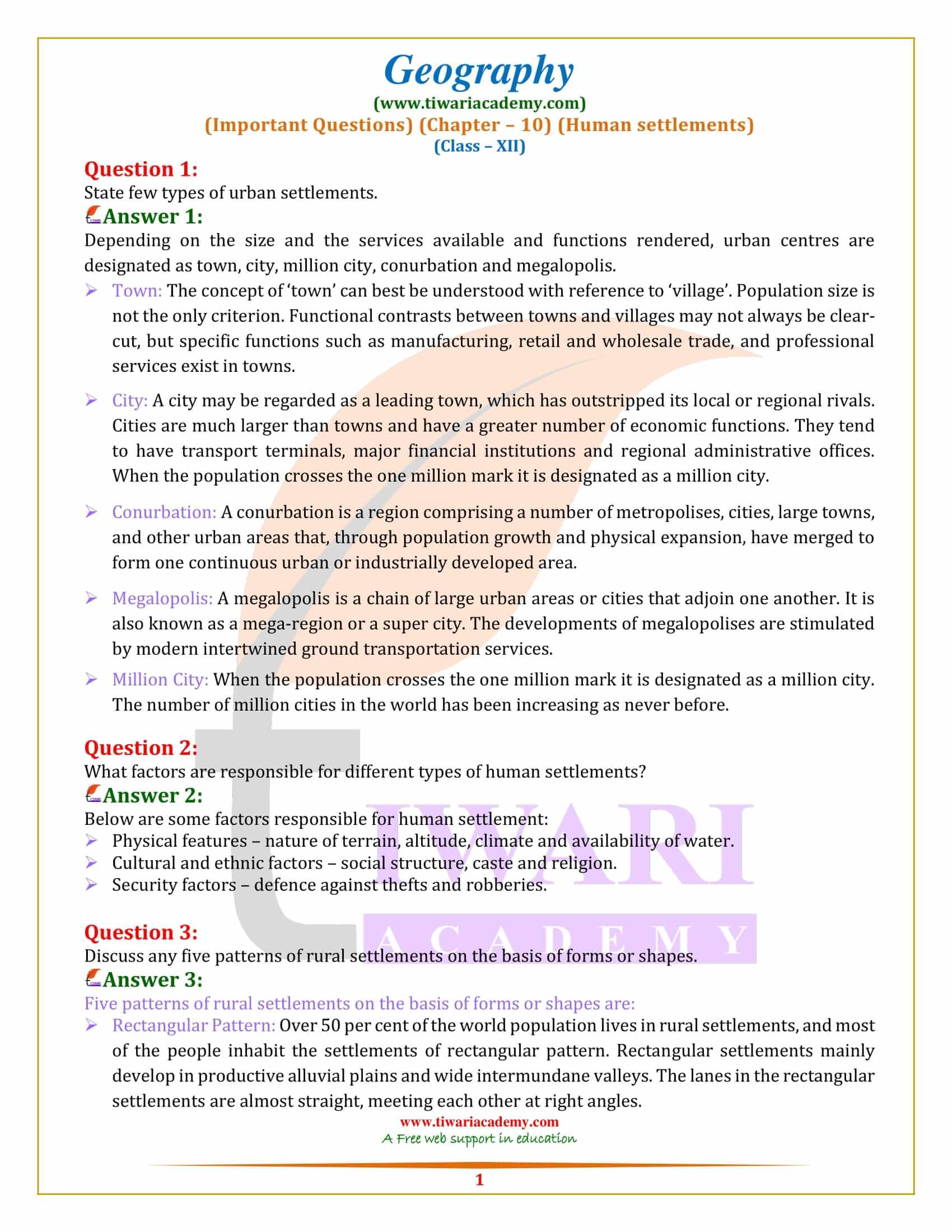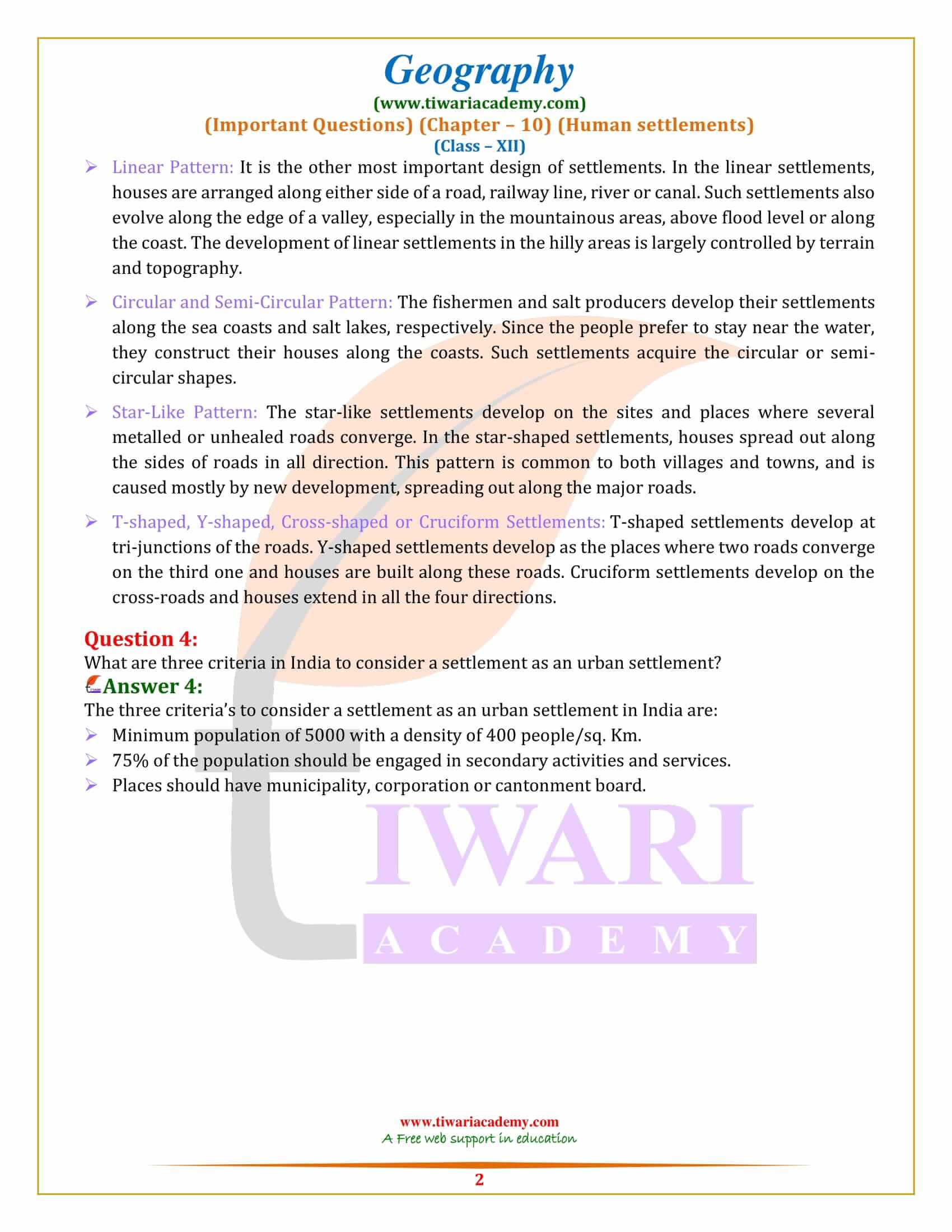NCERT Solutions for Class 12 Geography Chapter 10 Important Questions of Human Settlements to prepare for CBSE exams 2025-26. Class 12 Geography chapter 10 extra questions of Fundamentals of Human Geography covers the entire chapter and good study material for revision.
Class 12 Geography Chapter 10 Important Questions
Class 12 Geography Chapter 10 Important Extra Question Answers
State few types of urban settlements.
Depending on the size and the services available and functions rendered, urban centres are designated as town, city, million city, conurbation and megalopolis.
Town: The concept of ‘town’ can best be understood with reference to ‘village’. Population size is not the only criterion. Functional contrasts between towns and villages may not always be clear-cut, but specific functions such as manufacturing, retail and wholesale trade, and professional services exist in towns.
City: A city may be regarded as a leading town, which has outstripped its local or regional rivals. Cities are much larger than towns and have a greater number of economic functions. They tend to have transport terminals, major financial institutions and regional administrative offices. When the population crosses the one million mark it is designated as a million city.
Conurbation: A conurbation is a region comprising a number of metropolises, cities, large towns, and other urban areas that, through population growth and physical expansion, have merged to form one continuous urban or industrially developed area.
Megalopolis: A megalopolis is a chain of large urban areas or cities that adjoin one another. It is also known as a mega-region or a super city. The developments of megalopolises are stimulated by modern intertwined ground transportation services.
Million City: When the population crosses the one million mark it is designated as a million city. The number of million cities in the world has been increasing as never before.
What factors are responsible for different types of human settlements?
Below are some factors responsible for human settlement:
- Physical features – nature of terrain, altitude, climate and availability of water.
- Cultural and ethnic factors – social structure, caste and religion.
- Security factors – defence against thefts and robberies.
Discuss any five patterns of rural settlements on the basis of forms or shapes.
Five patterns of rural settlements on the basis of forms or shapes are:
Rectangular Pattern: Over 50 per cent of the world population lives in rural settlements, and most of the people inhabit the settlements of rectangular pattern. Rectangular settlements mainly develop in productive alluvial plains and wide inter mundane valleys. The lanes in the rectangular settlements are almost straight, meeting each other at right angles.
Linear Pattern: It is the other most important design of settlements. In the linear settlements, houses are arranged along either side of a road, railway line, river or canal. Such settlements also evolve along the edge of a valley, especially in the mountainous areas, above flood level or along the coast. The development of linear settlements in the hilly areas is largely controlled by terrain and topography.
Circular and Semi-Circular Pattern: The fishermen and salt producers develop their settlements along the sea coasts and salt lakes, respectively. Since the people prefer to stay near the water, they construct their houses along the coasts. Such settlements acquire the circular or semi-circular shapes.
Star-Like Pattern: The star-like settlements develop on the sites and places where several metaled or unhealed roads converge. In the star-shaped settlements, houses spread out along the sides of roads in all direction. This pattern is common to both villages and towns, and is caused mostly by new development, spreading out along the major roads.
T-shaped, Y-shaped, Cross-shaped or Cruciform Settlements: T-shaped settlements develop at tri-junctions of the roads. Y-shaped settlements develop as the places where two roads converge on the third one and houses are built along these roads. Cruciform settlements develop on the cross-roads and houses extend in all the four directions.
What are three criteria in India to consider a settlement as an urban settlement?
The three criteria’s to consider a settlement as an urban settlement in India are:
- Minimum population of 5000 with a density of 400 people/sq. Km.
- 75% of the population should be engaged in secondary activities and services.
- Places should have municipality, corporation or cantonment board.





